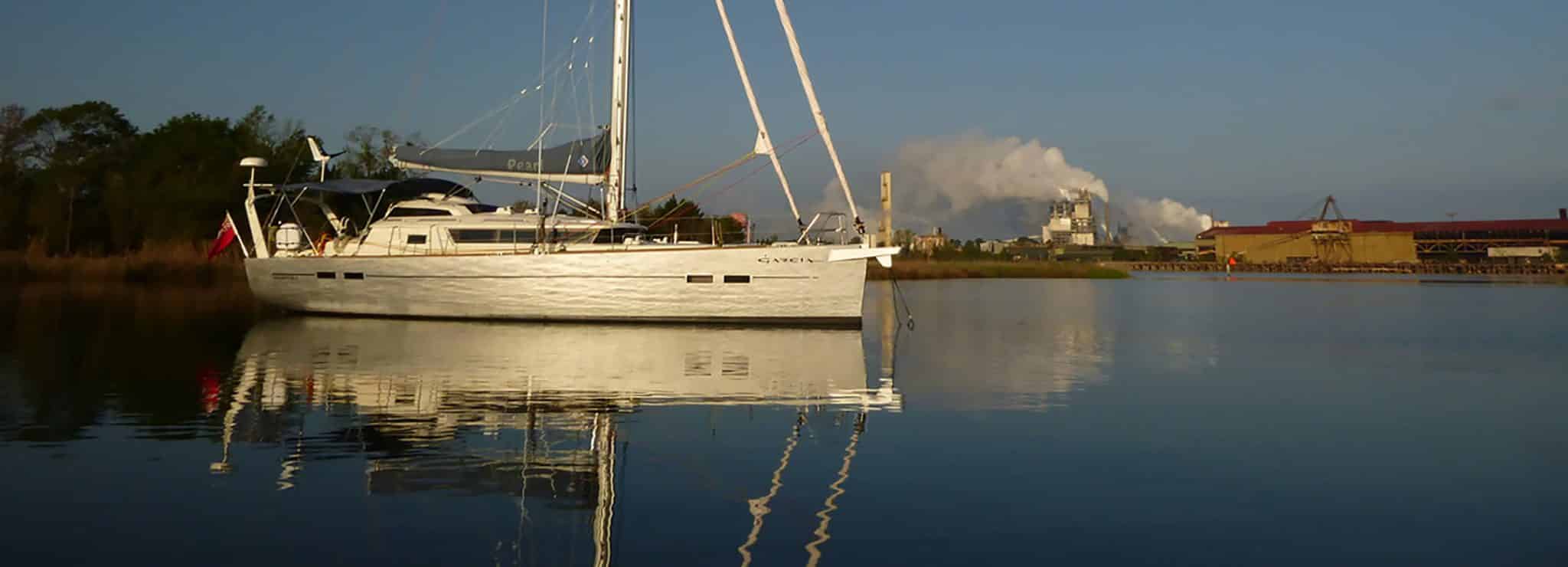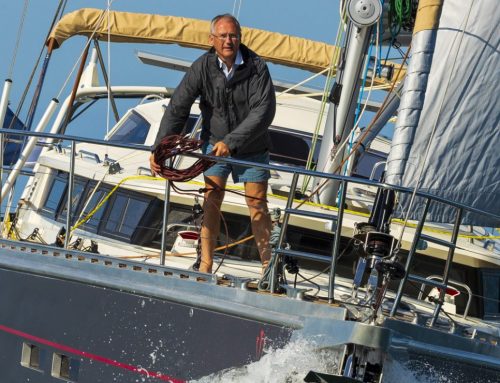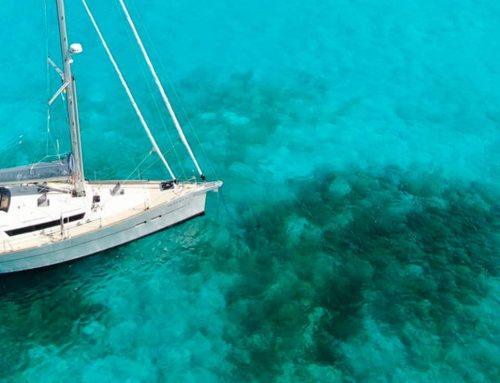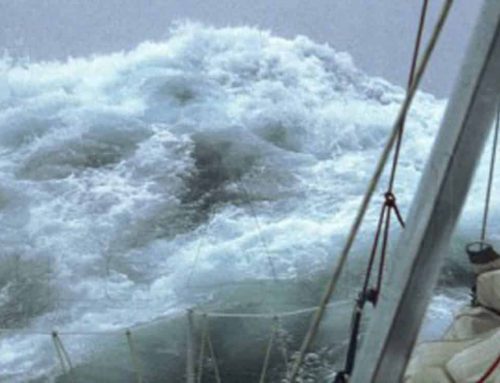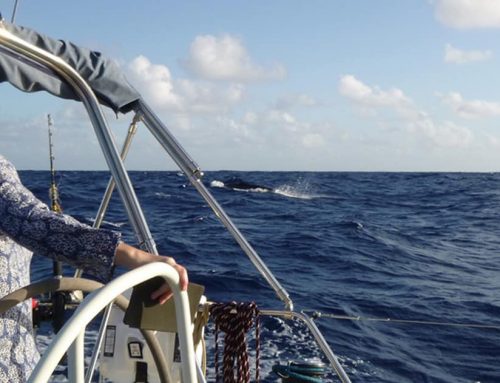This chronicle is the second of six written by British sailor and author Pete Goss.
Find the page to all chronicles by clicking here: Long time cruising, a voyage of many highlights
Discover more about Pete Goss by visiting his official website.
I was recently asked by someone searching the internet for their dream boat ‘what makes a sailing boat an expedition one’. It’s an interesting question for the answer rests with what ‘expedition’ means on an individual level. At the sharp end of the wedge you have boats like Skip Novak’s 48 ton Pelagic Australis which is designed to survive the harshest of conditions and yet remain a safe warm haven for those on board. A rugged base camp able to serve many aspirations from scientific research to remote mountaineering. Whilst we are all drawn to something of this nature she remains, as a little ship, well beyond most peoples needs, budgets and levels of experience.
As the wedge of choice widens so you find a limited number of boats that enable safe exploration of the same remote stomping ground. Less of a base camp, more of a yacht that can safely take you down the path less trodden. Yachts through which a couple, family or group of friends can stretch their horizons in safety and comfort. Not quite so rugged but without the strictures of a commercial time table able to wait for preferable weather windows.
Further widening of the same wedge will eventually bring you to the domaine of plastic production boats which are designed to coexist with the support of marinas. A combination which has created a genre that are full of bunks, have limited tankage, wanting stowage and safety pared to the bare minimum. These boats, which admirably serve their purpose, should ride out even moderately bad weather alongside a pontoon. They certainly don’t merit the loosest definition of an expedition boat and can be quickly culled by their inability to facilitate long periods of self sufficient sailing.
Building fundamentals
To warrant the expedition label a boat must be of rugged construction in either steel or aluminium with water tight bulkheads at either end. She needs to be well insulated with double glazing and an efficient heating system. She should have a propulsion system that can punch the boat through rough seas for a long period of time. The rig must be strong, have a simple reliable sail plan with a particular eye on heavy airs. The cockpit should be protected and there must be an excellent anchoring system. Every aspect of the boat should be designed and built with redundancy in mind.
In my opinion there are a small number of boats that fit this bill and between them its tough to make the right choice. Rather than following your heart it is much more penetrative sit down and really define the scope of adventuring that you wish to undertake. Only a clear and dispassionate definition of your aspirations will shine a light on the right boat for you, be it within the expedition category or not. For that’s what yachts are; ‘enablers of adventure’. Remember, a beginner can glean the same challenges and rewards from a channel crossing as an experienced transatlantic voyage.
Knowing well what you are looking for
The fluidity of boat choice against proposed adventure can be illustrated by our next boat. Changing family circumstances meant that we had to tighten the reach of our cruising area and so we sold our wonderful world girdling ‘Pearl of Penzance’. Needing to remain closer to home our next adventure is to explore the coast, upper reaches, rivers and canals of Europe. As such we have designed a 32ft Ply/epoxy boat to be called ‘Oddity’. Although ocean capable she can quickly drop her mast to become a river boat able to negotiate low bridges. She has a 10mm metal shoe to protect her bottom so that if caught out by winter in a remote area she can be dragged ashore behind a tractor.
“We never regretted the choice for a capable boat that will always serve above and beyond the call of duty.”
For the purposes of this article I want to focus on the defining features that lead us to buying our wonderful Garcia 45 Exploration ‘Pearl of Penzance’. Although we didn’t get to tread the path less traveled we never regretted the choice for a capable boat that will always serve above and beyond the call of duty. Like an onion there were many layers to be pealed back before the right boat for us was revealed.
‘Pearl’ was a huge investment for us which entailed selling up and jumping in with both feet. The kids had left home giving us licence to head off but we were also aware that ageing parents and hopefully grandchildren would eventually pull us back. With this in mind we felt it important to choose a boat that would both hold its value and remain a sort after asset. Factoring this beginning to end life-cycle into our choice proved to be prudent for when we asked it of her ‘Pearl’ sold in a flash.
It was nice to see that despite Tracey being a novice our requirements of choice complemented each other. I wanted a strong practical boat offering complete safety, lots of redundancy and fitted out to exacting standards. With our window of opportunity ticking away it was imperative that the boat serve our needs as opposed to us serving the boat. Tracey’s focus was for a home from home to include the all comforts from double glazing, fridge, freezer and a hot shower. Above all it must be light airy and have a pilot house for she could never understand a vehicle designed to take you to exotic locations only to provide accommodate in a cave below.
Aluminium and centre board, a profitable association
Over my career I have sailed all manner of craft built from fibre glass, carbon, wood, steel and in ‘Pearls’ case, aluminium. Every material has its place but for a live aboard boat with extensive aspirations I would plumb for aluminium. Its a strong light material which protects itself through a self healing skin of oxidisation. You can of course paint it but to me this negates the benefit of oxidisation and opens the door to unnecessary maintenance. Indeed, we started off with a lacquer on ‘Pearl’ which we eventually sanded back to bare metal and never looked back.
One of the best decisions we made was to opt for a centre board over a lifting keel. With confusion between the two I feel compelled to set out a brief comparison starting with righting moment. An absolute fundamental which is lost as a keel is lifted. We, on the other hand, were able to surf down Atlantic swells with the confidence of fixed ballast whatever the centre board position. Able to lift the centre board under sail meant that the boat didn’t trip up off the wind and so became directional stable to the point of being docile. This in turn gave a more comfortable ride, de-stressed all areas of the boat including the autopilot and power consumption. As an aside we gained an extra half knot on lifting the centreboard when motoring.
Without the need to lift tons of ballast we benefited from a scaled up dinghy system with a control line in the cockpit to lower the board by hand and raise it in first gear on a winch. An elegantly simple system that brings reliability as it sweeps away the need for complex hydraulics and a huge keel box erupting through the accommodation..
Our draft was 3ft 7inches with the board up and 9ft with it down which give us better windward performance than I had hoped for. If done well the best of both worlds can be had and the benefits of a shallow mode are many. When faced with a busy anchorage that clear area of no-man’s land between the anchorage field and the shore was all ours. If someone did drag then they dragged away from us. Of course, this opportunity is open to a lifting keel but theirs will be the mast that ticktocks back and forth due to reduced righting moment.
One of the joys of cruising ‘Pearl’ was that we had access to stunning little anchorages denied to deeper draft boats. Should we hit the bottom with the board down it simply pivoted and, as opposed to a major crash, acted as a sounding stick. We had the option of drying out for maintenance or wriggling into a hurricane hole to sit a blow with the confidence of full righting moment. In short lifting keels and centre boards are separated by a vast chasm and we were ever grateful to be on the right side of it.
When the boat becomes a creator of good memories
Tracey wanted to have the sleeping accommodation separated by the galley and saloon. Our end would require a generous double berth accessed on either side and supported by a generous ensuite. At the other side of the saloon must be another double cabin supported by a separate heads. This separation paid dividends as visitors suffering from jet-lag could lie in without disrupting our daily routine which starts with an early cuppa. Generous and easily accessible stowage was a given for both of us with a separate technical room for tools and spares.
“So there we have the concept: a safe comfortable enabler of dreams”
So there we have the concept: a safe comfortable enabler of dreams but how big should she be. We opted for forty five feet for this felt big enough to accommodate visitors and go anywhere but small enough to be managed by the two of us with ease. We didn’t want to be beholden to crew and so it was important that all controls came back to the cockpit. A cockpit that must provide both shelter from the elements and an entertainment area for sun downers.
So many accidents happen when boarding from a dinghy, anchoring or coming alongside. To this end I wanted good visibility and control from the steering position. A safe open transom for boarding, a good rugged anchoring system and a bow thruster. All of which made for two and a half years of the most life affirming experience of our lives. I was once told to spend my money on memories and good memories in this case rested on making the right boat choice.
